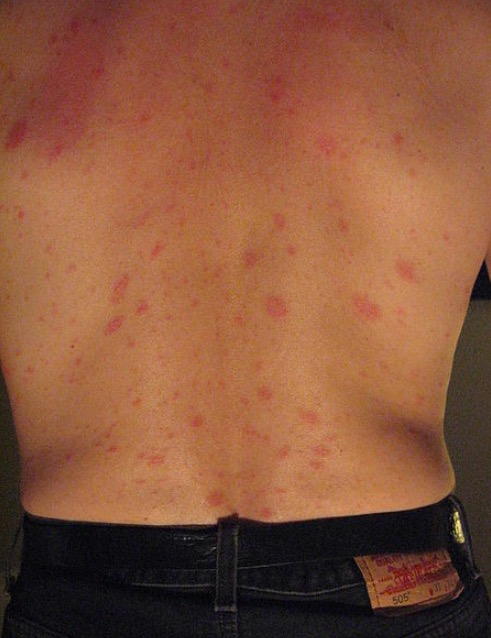Playlist
Show Playlist
Hide Playlist
Pityriasis Rosea in Darker Skin: Presentation, Diagnosis, and Management
-
Slides Pityriasis Rosea in Darker Skin.pdf
-
Download Lecture Overview
00:01 Welcome to our lecture on Pityriasis rosea. 00:07 What is Pityriasis rosea? It is an acute, self-limiting, exanthematous skin disease that usually resolves in 6 to 10 weeks. 00:20 If we look at the epidemiology of Pityriasis rosea, it typically affects people between 10 to 35 years of age. It's more often seen in women with an incidence of about 170 cases per 100,000 per year. 00:37 Now let's talk about the etiology of Pityriasis rosea, or causes of Pityriasis rosea. 00:43 The actual cause of Pityriasis rosea is unknown, but a viral etiology, probably due to herpes type six and seven, has been implicated. 00:56 And these are the following factors why we think it could be viral. 01:01 The fact that it is preceded by prodromal flu like symptoms in some patients. 01:06 The appearance in small case clusters, that is, clusters of patients who develop pityriasis rosea. The seasonal variation, the fact that it's more common in the spring and fall. And of course, the virus like particles which have been found in Pityriasis rosea biopsy specimens. The last point that point towards viral ontology is the fact that lifelong immunity is rare but possible. So let's look at the clinical manifestations of Pityriasis rosea. 01:46 The general symptoms include mild to severe itchy skin, and this occurs in about 25% of patients. 01:58 About 70% of patients will have flu like symptoms just a few days prior to the rash. 02:06 There is something that we called the Herald or "Mother" Patch. 02:11 So what is the "mother patch" or Herald? It is a single round or oval well-demarcated salmon pink lesion in white patients, which is about 2 to 5cm in diameter. 02:24 And of course, in black patients you don't see the salmon pink lesion. 02:28 You see a different darkish lichenoid scaly lesion. 02:33 It is usually surrounded by collarette of scale or a collar of fine white scales, which has been likened to cigarette paper. 02:44 So how does it present in dark skin? The Herald patch is usually dull reddish brown to deep brown in color. 02:56 And the predilection sites include the neck, the chest, the back. One m ay actually develop a few secondary lesions, and these can occur a few days to weeks after the appearance of the Herald patch. 03:13 So you get the Herald patch, and then a few days or weeks later you get the secondary eruption. And this is what we see with the generalized rash that occurs a couple of days or weeks after the Herald patch. 03:28 What's the distribution of the lesions? The lesions they follow what we call Langer lines, resulting in a Christmas tree distribution, which one normally sees at the back of the patient. 03:43 In light-skinned patients, one gets multiple salmon pink scaly patches, which are much smaller than the Herald patch and predominantly the location is on the chest and at the back. What about the dark skin? How is the presentation different in people with melanin-rich skin? So in patients with melanin-rich skin, it's more commonly presents as edematous papules or papular vessels rather than as flat, scaly patches. 04:16 So you realize why it is common to learn the different presentations in white skin and dark skin, because it's totally different. 04:24 We want to look now at type of Pityriasis rosea called inverse pityriasis rosea. 04:30 We spoke about the classical pityriasis rosea, which is a Christmas tree pattern at the back, the Herald patch and the clinical presentations in both white and dark skin. 04:40 Now we're going to talk about another clinical type which is inverse Pityriasis rosea. 04:46 In this type of rosea you get lesions predominantly present in acral and flexural areas, that is, in the axilla, groin, and sometimes on the face. 04:57 The other type of petasos is what we call extensive or explosive Pityriasis rosea. 05:05 This type of rosacea is quite extensive. 05:08 It can be itchy and is usually seen in patients who have immunocompromised disease like HIV. 05:17 So we've looked at the clinical types of rosacea. 05:20 Now we want to move on and talk about how do we diagnose Pityriasis rosea. 05:25 Usually it's a typical clinical diagnosis, but the history and physical examination is also important. A skin biopsy may be done, but it's really necessary. 05:40 And if it is done it shows features of a subacute dermatitis on histology. 05:47 What else can look like Pityriasis rosea. 05:50 So we're moving on to the differential diagnosis because we always have to say what is? What are we looking at? What could it be? What is for? And what is against the condition that we're looking at? Tinea corporis, which is fungal infection of the skin, can resemble Pityriasis rosea, particularly the herald patch or the mother patch. 06:15 So one has to always think about this. 06:17 So one m ay need to do skin scraping and preparation to differentiate between the two, that is the herald patch and tinea corporis. 06:27 Tinea corporis tend to be very itchy. 06:30 However, we also know that a small percentage of patients with Pityriasis rosea can present with pruritis. So when you do your KOH, you will see the hyphae, which are typical of fungal infection. 06:43 Tinea versicolor is another fungal infection that can closely resemble a Pityriasis rosea , but in these patients they present with hypopigmented or Hyperpigmented macules. 06:55 But unlike Pityriasis rosea, erythema is absent or minimal in patients with tinea versicolor, and tinea versicolor is usually totally asymptomatic that it is not itchy. 07:10 Guttate psoriasis is another differential of Pityriasis rosea, and we know that psoriasis is a type of psoriasis and is a variant of clinical psoriasis. 07:20 We'll talk about that in another lecture. 07:22 And it frequently affects children and young adults. 07:26 In guttate psoriasis, the scale is much coarser than the one that is seen in Pityriasis rosea . 07:32 So those are the main differentials of Pityriasis rosea . 07:36 Now we're moving on to talk about management. 07:38 How do we treat these patients. 07:41 The treatment really is focused on managing the itchiness Pruritus. 07:47 We try and moisturize the creams for dry skin. 07:51 Bathing or showering with plain water or bath oil also is helpful and moderate potent topical steroids are the main cornerstone of treatment of Pityriasis rosea, particularly if it is symptomatic and severe. 08:07 A short course of systemic corticosteroids for severe Pityriasis rosea is always indicated in patients with extensive disease, intense pruritus, or where it may be associated with HIV and is actually very severe. 08:23 Acyclovir has also been used for faster resolution. 08:27 Remember, we mentioned that the herpes virus type six and 7 m ay be implicated in patients with Pityriasis rosea. So there is some literature pointing at the fact that a cycle of oil may be used, but rarely.
About the Lecture
The lecture Pityriasis Rosea in Darker Skin: Presentation, Diagnosis, and Management by Ncoza Dlova is from the course Inflammatory Diseases in Patients with Darker Skin.
Included Quiz Questions
How does the Herald patch typically present in patients with dark skin?
- Dull reddish-brown to deep brown lesion with collarette of scale
- Salmon pink oval patch with fine, white scaling
- Bright red circular patch without scaling
- Yellow-brown patch with thick scaling
- Purple patch with central clearing
Which finding best supports the viral etiology of pityriasis rosea?
- Presence of prodromal flu-like symptoms in most of patients
- Positive response to antibiotics
- Regular occurrence in family members
- Consistently positive bacterial cultures
- Complete lifelong immunity is common
Which pattern is characteristic of classical pityriasis rosea on the back?
- Christmas tree distribution following Langer's lines
- Random scattered pattern
- Symmetrical butterfly distribution
- Linear arrangement
- Circular clustered pattern
Which treatment is most appropriate for a patient with severe, pruritic pityriasis rosea?
- Short course of systemic corticosteroids
- Topical antifungal medications
- Long-term antihistamines
- Brief course of antibiotics
- Phototherapy alone
Customer reviews
5,0 of 5 stars
| 5 Stars |
|
5 |
| 4 Stars |
|
0 |
| 3 Stars |
|
0 |
| 2 Stars |
|
0 |
| 1 Star |
|
0 |




